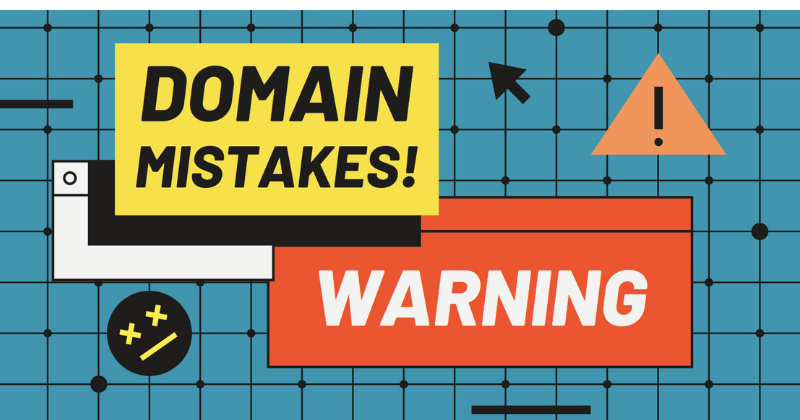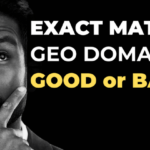Learn from the Domain Name Mistakes of Real Brands—and How to Avoid Them
In the digital economy we live in, domain name is no longer a minor detail—but the digital front door to your brand, your credibility, and your customer trust.
But what happens when your domain name becomes a liability?
Thousands of startups and business owners face costly mistakes and painful setbacks with domain names they didn’t plan for.
From losing domain access to realizing that “someone else owns my domain name”, these real-world challenges can disrupt business growth, kill SEO rankings, and even damage your brand’s trustworthiness overnight.
Who This Series Is For
This isn’t just for domain flippers or tech geeks. These articles is for:
a. Startup founders trying to secure the perfect domain
b. Marketing leaders planning a rebrand or new product launch
c. Brand managers looking to boost trust and consistency
d. Business owners wondering why traffic, trust, or conversions are down
If you’re responsible for your company’s online presence, domain decisions are brand decisions.
We’ll walk you through the most common domain name pain points faced by entrepreneurs, startups, and established businesses—and how to solve them before they become costly crises.
The 10 Most Common Domain Name Mistakes That Hurt Businesses
Each of the following guides is inspired by true domain name problems startups and businesses face every day. These aren’t hypothetical—they’re based on real pain points, and they come with real consequences.
1. Someone Else Owns My Brand’s Domain—What Should I Do?
You’ve secured your business name, set up branding, and launched your product… only to find that your .com domain is already taken.
This is one of the most searched domain-related frustrations, often worded as:
“What to do if domain name is taken”
“How to buy a domain name that is already registered”
You might have trademarked the name. You may have spent thousands building your brand. But if someone else registered the domain before you did, they legally own that digital asset.
Why This Happens:
- The domain was purchased by a domain investor long before you built your brand.
- A competitor or cybersquatter may be holding the domain for leverage.
- It could be parked with no content—but still unavailable.
Solutions:
- Reach out to the owner and try to negotiate ethically.
- Hire a domain broker to act on your behalf and avoid inflating the price.
- Use a short-term workaround with a different domain (but plan for an upgrade).
- Consider domain dispute resolution only if your brand is legally protected (trademarked).
This guide will break down what to do next—legally, ethically, and strategically—whether that means negotiation, using a domain broker, or planning a brand-aligned alternative.
Read the Full Article → Someone Else Owns My Domain—What Should I Do?
2. What Happens If You Lose Your Domain? (And How to Prevent It)
Did you know one missed renewal can wipe out your entire online presence?
It happens even to billion-dollar brands. Forgetting to renew your domain name can cause your entire business to go offline—taking down your website, your emails, and your credibility.
It’s a common yet devastating problem, especially for small teams or solo founders. Many users search things like:
“Domain expired—website not working”
“Lost domain name recovery process”
“Recently expired domain names“
Real-World Example:
In 2017, Marketo, a global marketing software company, forgot to renew Marketo.com. (On September 20, 2018, Adobe Systems announced that it was buying Marketo for $4.75 billion.)
The result? – Their website and customer portals went down, clients couldn’t log in, and email communications were disrupted for a full day.
The lesson?
Treat your domain name as your most valuable digital asset because it’s the foundation of your online presence.
Prevention Tips:
- Enable auto-renewal on all important domain names.
- Set up multiple alerts in case payment methods fail.
- Use a domain registrar that offers renewal grace periods.
Learn what happens when your domain expires, how to recover it (if possible), and how to set up auto-renewals and backups to protect your business from avoidable downtime.
Read the Full Article → Why Your Business Can’t Afford to Lose Its Domain Name
3. Choosing the Wrong Domain for Your Brand: Can You Fix It Later?
You launched fast. You picked a domain that was available—maybe it was a .co, .net, or a clever workaround. But now you’re growing, and the cracks are starting to show.
Your customers type the wrong domain. Your brand looks less established than your competitors. And you’re wondering:
“Is this domain actually holding us back?”
This guide dives deep into the real-world consequences of domain regret—from lost traffic to SEO headaches and trust issues. More importantly, it shows you how startups and global brands alike have corrected course by switching to stronger, more brand-aligned domains.
– Learn how to fix a bad domain name without tanking your search rankings
– See real case studies like Twitter’s switch from Twttr.com to Twitter.com
– Get a step-by-step migration strategy that protects your SEO
If your domain name no longer fits your brand, this guide will help you make the switch—smartly, strategically, and without losing momentum.
Read the full article about “Signs You Picked the Wrong Domain Name“
4. Why My Brand Isn’t Ranking on Google—Could It Be the Domain?
You’ve done your SEO. You have content. You’ve even run ads. But still… no traffic.
Business owners often search:
“Why is my website not showing up in Google”
“Does my domain name affect SEO ranking”
We explain how factors like domain age, keywords in the domain, and brand-to-domain match can directly affect your visibility—and what to do if your domain is dragging you down.
Read the Full Article → How Domain Names Impact SEO & Branding: Best Practices for Higher Rankings
5. My Domain Is Too Long or Hard to Remember—Is It Hurting My Business?
People can’t find your website. Referrals are misspelled. Your email bounces. It might not be your service—it might be your domain name.
Real-world searches:
“Is my domain name too long?”
“How to choose a memorable domain name”
This valuable piece of information shares why length, clarity, and memorability matter, with practical advice and brandable alternatives to help make your domain stick in people’s minds.
Read the full content of this article about Too Long Domain Name is Hurting Your Business.
6. Should I Change My Business Name to Match a Better Domain?
Sometimes, the best domain isn’t just taken—it’s wildly unaffordable or off-brand.
And for early-stage businesses, that creates the tough question:
“Should I rename my startup to get a better domain?”
“Brand name vs domain name—what’s more important?”
This guide explores rebranding from a domain-first perspective, with real-life case studies like Twitter.com and smart ways to rebrand and changing your business name without confusing your audience.
7. Is My Domain Costing Me Customers? (Real Trust & UX Mistakes)
Your domain may be turning people off without you realizing it. Think about this:
- Does it look spammy or unprofessional?
- Is it hard to spell or pronounce?
- Does your email domain match your business name?
These are subtle signs, but they can cost you clicks, trust, and sales.
Search queries include:
“Do domains affect conversion rates”
“Best domain practices for brand trust”
This domain insight show how better domains lead to better first impressions—and how to audit and upgrade your current setup.
8. I Didn’t Prioritize My Domain Early (Now It’s Expensive)
You were focused on product, growth, or funding. The domain could wait. But now that your business is gaining traction, that perfect name is no longer available—or the asking price is astronomical.
This is a classic issue with domain name strategy for startups.
What This Means for SEO:
Missing out on a brand-matching domain may force you into using longer, confusing URLs—hurting click-through rates, memorability, and even Google trust signals.
Smart Moves:
- Buy early, even if you’re not ready to launch the full website.
- Don’t wait until Series A to get the name you want—it may cost 10x more later.
- Explore brandable alternatives like Chatly.com instead of Chat.com.
Search phrases like “domain name mistakes startups make” or “why is my domain name important” reflect real educational intent—use those to create content that ranks.
You don’t want to miss this one. The article “Huge Reason Why You Should Buy Your Domain Name Early” is now published.
9. A Cybersquatter Registered My Name
This is where things get frustrating. You didn’t lose your domain, but someone else registered a close variation, like YourBrand.co, YourBrand.net, or even a typo like YourBrnad.com—and is now impersonating or profiting off your brand equity.
In some cases, they may try to sell the domain back to you at a high markup.
This tactic is known as cybersquatting, and it’s more common than you think.
How to Defend Against It:
- Register multiple variations of your domain (defensive registration).
- Consider acquiring misspellings and regional extensions.
- If necessary, work with a domain attorney or file a UDRP complaint.
We’re building this guide with real insights from business owners like you. The article “Cybersquatting: What to Do If Someone Registered Your Name” is now published and live online.
You may also read this article for more domain insight: What Is Ethical Domain Investing?
10. Your Domain Looks Like a Scam (Even If You’re Legit)
Even good brands sometimes choose bad domains—ones that trigger spam filters, bounce emails, or confuse Google.
Some domain names unintentionally come across as spammy, suspicious, or fake.
Think: hyphens, numbers, misspellings, or strange extensions.
If customers don’t feel safe clicking on your domain, you’re losing them—no matter how great your product is.
We share the biggest red flags and how to fix them fast.
Read our checklist of domain red flags and how to fix them before they hurt your reputation.
Bonus Section: Domain Protection Isn’t Just Defensive—It’s Strategic
Securing a domain name should not be an afterthought. It’s a foundational step in brand protection and digital ownership. Whether you’re a solopreneur or an enterprise, your domain strategy influences everything from marketing to M&A.
What You Can Do Right Now:
- Conduct a domain audit: Do you own the .com, misspellings, regional extensions?
- Talk to an ethical domain broker for long-term brand protection strategies.
- Set up alerts to track expiring domains related to your brand or niche.
Treat Your Domain Like a Core Business Asset
Let’s be clear—losing a domain name can cost you more than money. It can lead to:
- Lost customers
- Damaged brand trust
- SEO penalties
- PR disasters
Most domain issues don’t happen out of malice—they happen because they weren’t taken seriously enough.
Whether you’re a startup founder, marketing lead, or seasoned business owner, your domain name is a digital investment—and it’s never too early to protect it.
Need Help Securing or Upgrading Your Domain?
NamesDigest works with business owners and brand managers to evaluate domain value, resolve naming issues, and develop smart domain acquisition strategies. Let’s protect your digital identity—ethically and strategically.
At NamesDigest, we help brands:
- Evaluate domains based on brand value and SEO
- Ethically acquire domains (no cybersquatting or spam tactics)
- Avoid costly mistakes with real-world guidance
Contact us or Browse our blog for more domain branding insights













